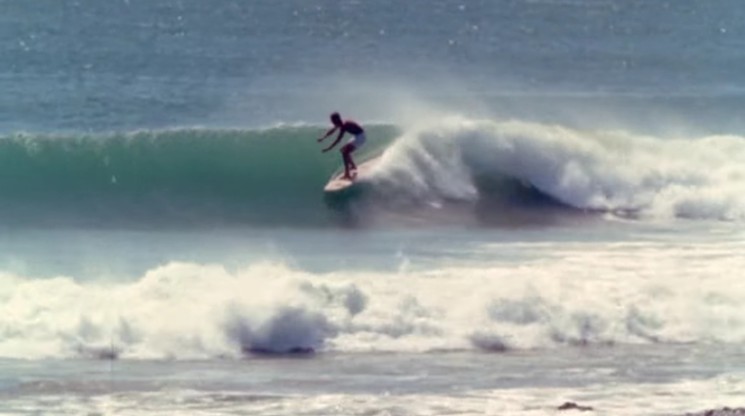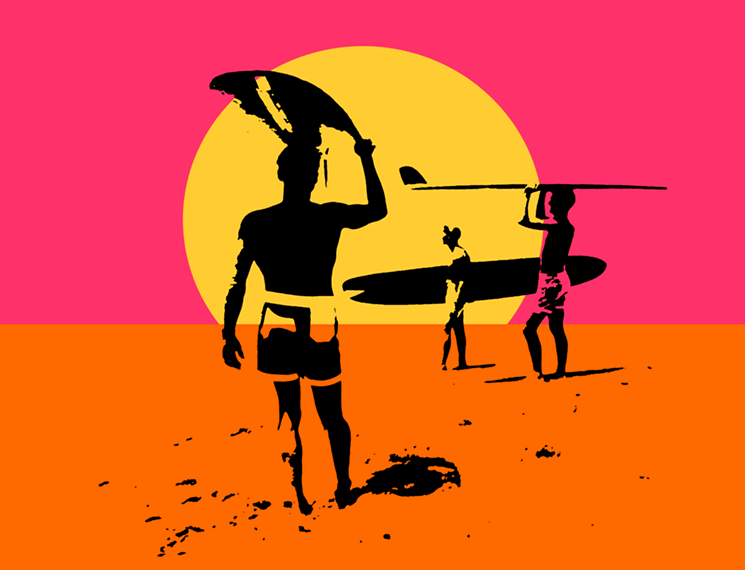BY KEITH PLOCEK
The morning of the perfect wave, Mike Hynson says he woke up early on an isolated cape in South Africa. Hynson and his companions had rolled up to a small village in the middle of the night, five guys crammed in a van with just two seats. The driver was a South African named Terence who captured animals for zoos. Terence liked to toss snakes in the back of the van. He was the only one who thought that was funny.
Hynson saw a little wave ripple across a distant cove, and he thought it might be something worth checking out. He’d been traveling with fellow surfer Robert August and filmmaker Bruce Brown around the world in search of waves, and so far they’d found squat. Sure, they’d paddled out in Senegal and Ghana, but those waves were nothing like the ones back home in Southern California. Hynson smoked a few cigarettes and waited for August and Brown to wake up.
Around 10 or 11, Hynson’s companions finally emerged from their huts. The three sat on the beach, looking out at the Indian Ocean. Only a few weeks into their trip, they were already getting on one another’s nerves. The main road from Cape Town to Durban wound along the coast about 10 miles inland, and they’d taken just about every bumpy trail on the map that veered toward the water, often peering off a cliff before turning around and bouncing back inland again.
Hynson was fed up with August and Brown, but dealing with a couple of squares was still better than facing all the Vietnam draft board notices piling up at home.
He kept seeing little ripples in a cove that curved behind them, but every time he nudged Brown, the waves were gone. Brown started to wonder if Hynson was just messing with him. Finally Hynson grabbed his white, red and blue 10-foot-long surfboard and marched down the beach alone.
That’s when he saw the waves again. Four of them. Perfect. Coming through in a clean set.
Surfers generally are careful about entering foreign waters. There are sharks, rocks, the unknown. But Hynson couldn’t contain his excitement.
“As soon as I hit the water and paddled out, it was so magical,” he says. Another little set came through, and Hynson let the first wave pass, then the second. The third was his. He paddled and popped up. “And I kept going and going. I was just standing there. And then I realized I’d better kick out of this wave — I’m going to need a taxi to come back.”
Hynson sat on his board and looked back down the beach. August and Brown were running toward him. Brown was dragging his equipment, and August’s board carved a trench in the sand as he pulled it along. Brown set up his camera, and August paddled out to join Hynson.
For 45 minutes they surfed wave after wave. To exhaustion. August vomited in the water from the excitement.
Later that day, Brown would film them marching across nearby sand dunes, pretending that’s how they came upon the magical point break for the first time. The next day they’d go back and the waves would be so flat they’d barely recognize the spot. But that wouldn’t matter. Brown got the footage he needed to make the entire trip worthwhile. The Endless Summer would feature shots from beaches around the globe, including Australia, New Zealand, Tahiti and Hawaii, but it was those waves at Cape St. Francis that made the flick.

After the movie was edited, Hynson and Brown toured around the United States in a bus in the summer of 1964, screening the documentary in high school auditoriums and Lions Clubs. The film originally didn’t even have audio, and Brown would play surf records and narrate the action live. Every time those shots from Cape St. Francis came on the screen, Hynson would feel exhilarated all over again. He’d ridden the perfect wave, a point break ripper all to himself.
“That sequence, coming over the sand dunes and finding that offshore, fun-feeling wave, just floored so many surfers and so many people,” says surf photographer Craig Peterson, who first saw the movie as a teenager.
Read the rest of this article…

